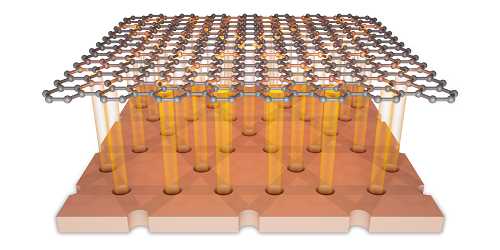Electronic Bands Get a New Tuning Knob
For almost a century, scientists have been trying to tune the electronic band structures of materials so that those materials exhibit desired physical properties. In the past few years, researchers have shown they can manipulate the band structures of graphene and other 2D materials using electric-field configurations that produce simple periodic potentials. Now Changgan Zeng at the University of Science and Technology of China and his colleagues have shown that they can achieve greater control over the band structure using an electric potential with a shape that resembles a basket-weaving pattern known as kagome [1]. The researchers say that their new “tuning knob” paves the way for on-demand electronic band design for a wide variety of 2D-material systems. The method could “open up new opportunities to induce properties not inherent in natural materials,” Zeng says.
Zeng and his colleagues physically etched a kagome pattern, which consists of triangles and hexagons, into a piece of graphite a few atoms thick. They sandwiched this patterned graphite sheet between a block of silicon (bottom) and a block of hexagonal boron nitride (top) that contained a layer of graphene. The researchers then applied separate voltages to the graphite and silicon layers. This setup subjected the graphene to a kagome-shaped electric potential whose strength the researchers showed they could alter by adjusting the magnitudes of the two applied voltages. Zeng and his colleagues demonstrated use of their specially crafted potential to manipulate key properties of the graphene’s band structure, such as the number and positions of the points where the valence and conduction bands meet.
–Ryan Wilkinson
Ryan Wilkinson is a Corresponding Editor for Physics Magazine based in Durham, UK.
References
- S. Wang et al., “Dispersion-selective band engineering in an artificial kagome superlattice,” Phys. Rev. Lett. 133, 066302 (2024).




